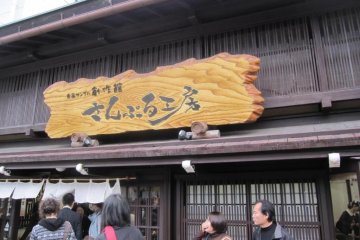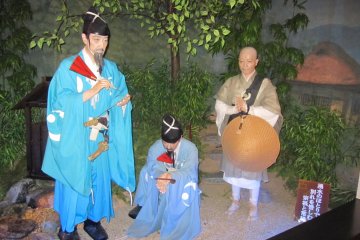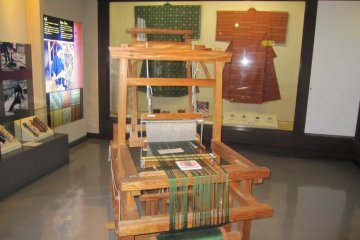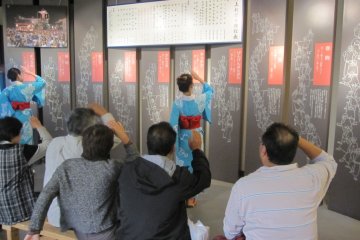Gujo has a proud history and culture. To celebrate and explain it to visitors can be difficult but one visit to the Hakurankan can.
The Hakurankan introduces history, local crafts and dance tied together through the theme of water, a binding force of the community.
Water
Water flows everywhere in Gujo and is the pride of the people and deeply rooted in their daily lives. From a very young age children play in the rivers while women use the streams between the houses to clean vegetables or shoes and men fish. Houses along the rivers have stairs to the river allowing family to easily retrieve water for cooking and cleaning.
The river is a symbol of maturity and adulthood. Young men train to jump from the Yoshida Bridge into a squared off 4 meter deep section of the river.
History
The history of Gujo is tied to water. Hachiman castle sits on a mountain over looking the convergence of three rivers: The Yoshida, Nagara and Kodara which provided the rocks for its foundation during the Waring States Period. During the Kamakura period, the waka poet Toshi began an multi-year years residence in Gujo (then Yamada So) writing about the people and their relationship to the water.
Local Crafts
Besides plastic sample food, Gujo has a history of dying hemp and silk which dates back hundreds of years. The process involves using vegetables and flowers to produce colors and then dipping the cloth in the cold river. Besides dying, by observing the likes and dislikes of moths and other cloth eating bugs, some crafty Gujo artists discovered an organic method of preservation that didn't affect the color fixing process.
Dance Dance Dance
The final section of the Hakurankan is all about the Gujo Bon Odori festival. The Bon season is from July to August and in the middle of this is the Gujo Bon Odori. All cities have Bon Odori but Gujo does 72 hours of non-stop dancing. There are several different dances to perform and knowing huge moves is a big deal. Three times a day dance instructors visit the Hakurankan and teach visitors the moves. Even the two-left footed can do it!
The museum flows easily and one can understand the different aspects of Gujo within an hour. But what the Hakurankan really does is wets your appetite to see and try more of what Gujo has to offer.











